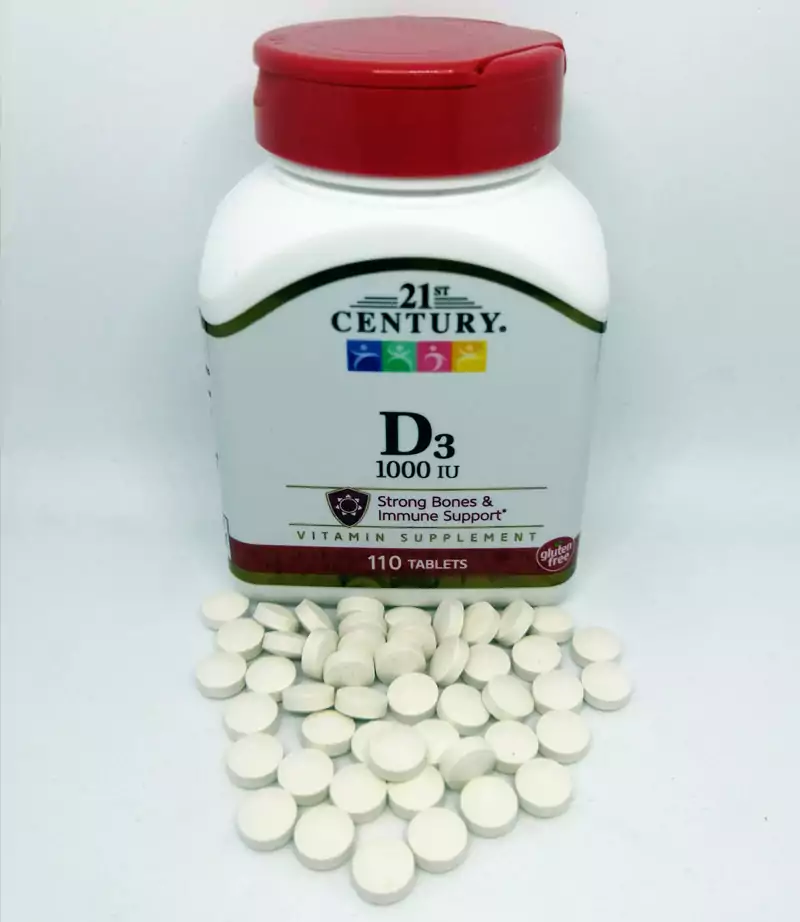Hello! Today, I will give you a detailed overview of vitamin D. This topic is very important, as a deficiency of vitamin D is observed in a huge number of people worldwide, and the consequences of its lack are quite unfortunate. So, we need to address this issue. I’m sure that after reading today’s article, you’ll understand the importance of this amazing vitamin.
Vitamin D: What It Is
It belongs to the group of fat-soluble vitamins, and fats are necessary for its absorption in the intestines.
By the way, check out my recent article about fats in food.
The primary function of vitamin D in the body is to ensure the health of bones and teeth.
Only in the presence of calciferol can calcium be fully absorbed.
This vitamin was discovered in the early 20th century during the search for a cure for rickets.
Further research proved that it strengthens the immune system, participates in metabolic processes, digestion, and the nervous system’s function.
Adequate levels of it in the blood help prevent the development of diabetes, depression, osteoporosis, and heart conditions.
At the end of the 20th century, scientists discovered that almost half of the population experiences a deficiency in vitamin D.
Multivitamin supplements and even special sports vitamins began to be produced.
However, uncontrolled intake of such supplements is more likely to lead to toxicity.
This substance can accumulate in fatty tissue (since it is fat-soluble) and cause unpleasant side effects.
Therefore, before taking calciferol supplements, it’s important to study its properties and recommended intake levels.
Forms of Vitamin D
Vitamin D is a group of biologically active substances.
Currently, six types have been identified:
- D1 can only be obtained artificially; it’s a combination of ergocalciferol and lumisterol.
- D2 or ergocalciferol enters the body with food, mainly found in plant-based products.
- D3 or cholecalciferol is the most active form. It not only comes from animal products but is also synthesized in the skin.
- D4 is stored in the epidermis and, under the influence of sunlight, is converted into D3.
- D5 is produced artificially.
- D6 has been found in certain plants and is currently being researched.
For health and proper body functioning, two forms are important: D2 and D3.
A common question arises: which one is better in vitamin supplements?
To answer this, it’s essential to note that D2 is not produced in the body and is present in supplements in an artificial form, which makes it less absorbable. To address a deficiency, D3 is recommended.
By the way, I found an interesting scientific study that compares these two forms in 12 healthy young individuals:
https://www.ncbi.nlm.nih.gov/pmc/articles/PMC5793240
Which Foods Contain the Most Vitamin D
This vitamin is not widely found in nature.
Cholecalciferol is only present in a few plant-based products.
These include wild mushrooms: chanterelles, shiitake, morels, button mushrooms, as well as seaweed and corn oil. As you can see, there’s nothing substantial, and in this form, it is also poorly absorbed.
The main sources of vitamin D are animal-based products.
They contain a well-absorbed form of cholecalciferol. The top sources are fatty fish varieties.
That’s why the best remedy for a deficiency of this substance is fish oil.
One tablespoon contains 1360 IU or 34 mcg.
100 grams of canned sardines provide a third of the daily requirement, while a glass of milk or two eggs covers 17%.
The table shows how much vitamin D is contained in 100 grams of food.
| Product | IU Amount | mcg Amount | % of Daily Value |
| Mackerel | 1008 | 25.2 | 168% |
| Carp | 988 | 24.7 | 164% |
| Pink Salmon | 529 | 13 | 86% |
| Red Caviar | 484 | 12.1 | 80% |
| Tuna | 441 | 11 | 75% |
| Egg Yolk | 216 | 5.4 | 36% |
| Herring | 216 | 5.4 | 36% |
| Chanterelle Mushrooms | 212 | 5.3 | 35% |
| Beef Liver | 117 | 2.9 | 18% |
| Kelp | 96 | 2.4 | 15% |
| Goat Milk | 52 | 1.3 | 8% |
Vitamin D Norms for Adults, Children, and Pregnant Women
Scientists have determined that the daily recommended intake of vitamin D varies by age:
- Children under 1 year need 400 IU, which equals 10 mcg.
- Children older than 1 year and adults require 600 IU or 15 mcg.
- The maximum daily dosage for children under 1 year is 1000-1500 IU (25-37 mcg), for children aged 1 to 8 years it is 2500-3000 IU (62-75 mcg), and for adults, it is 4000 IU or 100 mcg.
- For the elderly (over 70 years) and during pregnancy, the recommended daily intake is 800 IU. The maximum dosage of 4000 IU should not be exceeded.
When a Higher Dosage is Needed
Sometimes, for therapeutic purposes, you may need to increase your daily dosage, and a doctor may prescribe up to 10,000 IU of vitamin D.
It is recommended to take such amounts in the following cases:
- If a person lives in the north or in a smoggy city with limited sunlight.
- For those working night shifts.
- People with darker skin tones or those who frequently use sunscreen.
- Bedridden patients or those who rarely go outside.
- People with intestinal diseases that impair absorption.
- In cases of obesity.
- For women during pregnancy and lactation.
- In the elderly.
- During viral illnesses.
- For chronic conditions such as diabetes, arthritis, or hypertension.
Vitamin D3: Why the Body Needs It
Scientists have discovered that vitamin D is essential for the proper functioning of many organs and systems.
Here’s a very interesting article on vitamin D3:
https://www.ncbi.nlm.nih.gov/pmc/articles/PMC3356951
Vitamin D Functions:
- Ensures proper skeletal formation in children
- Maintains dental health
- Reduces fracture risks and speeds up healing
- Maintains adequate calcium levels in the blood
- Strengthens the immune system
- Participates in cell division
- Regulates carbohydrate metabolism and aids weight loss
- Slows down the aging process
- Reduces the risk of arthritis, multiple sclerosis, and diabetes
- Improves brain function, memory, and attention, and prevents depression
Medical Use:
The primary medical application of vitamin D is in the treatment of various diseases and pathological conditions.
Doctors prescribe it in the following cases:
- Osteoporosis, osteomalacia, rickets
- Cancerous tumors
- Psoriasis
- Diabetes
- Rheumatoid arthritis
- Multiple sclerosis
- Tuberculosis
- Hypertension, atherosclerosis
- Phosphorus deficiency in the blood
- Renal osteodystrophy
- Bronchial asthma
- For the prevention of colds
Sports:
I strongly recommend athletes take calciferol, but only after testing (more on that below) and consulting with a doctor.
It positively affects muscle strength and growth, stimulates testosterone production in men, and helps with rapid weight loss.
However, it should only be taken if a deficiency in the blood is confirmed by tests.
Cosmetology:
A lack of vitamin D worsens skin and hair conditions, which is why it is often used in cosmetology.
The oil solution is added to shampoos, balms, hair masks, and facial creams.
Effectiveness:
When taken in recommended doses during a treatment course, the effectiveness of vitamin D varies for different diseases.
Research results show that achieving normal calciferol levels in the blood leads to 100% effectiveness for rickets and osteomalacia. For other conditions, the effectiveness is as follows:
- 70-80% – cardiovascular diseases, infertility
- 50% – diabetes, fractures, multiple sclerosis, heart attack, breast cancer
- 25-35% – ovarian and uterine cancer
Vitamin D Deficiency
Cholecalciferol is produced in the epidermis under the influence of ultraviolet rays.
Even a short walk in light clothing on a sunny day replenishes the daily requirement.

If you spend a long time outside during the summer, vitamin D will be stored in subcutaneous fat to be used in the winter.
However, more than half of the population now suffers from a deficiency of this substance.
Those most affected are residents of northern regions (hello to everyone from Karelia), infants, people with dark skin, and the elderly.
Why Vitamin D Deficiency Occurs
There are several causes for vitamin D deficiency:
- Constant indoor living
- Wearing closed clothing, using sunscreen
- Digestive issues
- Various diets, unbalanced nutrition, lack of animal products in the diet
- Sedentary lifestyle, presence of body fat
Symptoms
In the early stages, vitamin D deficiency is not noticeable.
Mild discomfort and weakness are often mistaken for other conditions.
But gradually, more apparent symptoms develop:
- Frequent colds and infections
- Back and bone pain, posture issues
- Stress, depression
- Hair loss
- Tooth decay
- Slow-healing wounds
- Chronic fatigue
- Hormonal imbalances
- Weight gain
If you ignore these signs and don’t start taking vitamin supplements, the risk of developing atherosclerosis, diabetes, osteoporosis increases. Men may experience reduced potency, and women may develop infertility. Long-term cholecalciferol deficiency can lead to cancer.
Vitamin D Deficiency in Children
Vitamin D deficiency is particularly dangerous for infants. That’s why we are currently giving my little Mark vitamin D drops.
The deficiency poses risks such as slowed growth, improper development of the musculoskeletal system, skin diseases, and malfunction of many organs.
A serious condition that can develop in babies is rickets.
Severe forms of this condition can leave lifelong consequences, such as bone deformities.
Excess of Vitamin D3 in the Body
Cholecalciferol can accumulate in fat tissue.
However, dangerous consequences only develop from improper intake of supplements.
Overdosing can lead to the following side effects:
- Anorexia, weight loss
- Frequent urination
- Irregular heartbeat
- Nausea, abdominal pain
- Calcium deposits in blood vessels, joints
- Development of cardiosclerosis
Vitamin D Test
To be honest, I love getting various tests done.
Recently, I had another round of tests for the key hormones that every athlete should check, and I found some minor deviations (mostly due to stress), which I corrected in time, and now everything’s fine.
To determine if you need to take additional cholecalciferol supplements, a blood test is required.
In test results, vitamin D is marked as 25-OH.
- Normal = 30-100 ng/mL
- Insufficiency = 20-30 ng/mL
- Deficiency = below 20 ng/mL
The test should be taken in the morning, on an empty stomach, with the last meal being the previous evening.
Only water can be consumed before the test.
By the way, speaking of water, use the calculator I made for you to calculate how much water you need to drink.
How to Take Vitamin D3
Only a doctor can prescribe therapeutic doses of vitamin D after tests are done.
Be sure to follow the instructions for the supplements. Remember, as I mentioned earlier, vitamin D is fat-soluble, so its accumulation in fat tissue can be toxic.
For prevention, multivitamin complexes can be taken.
Zinc, magnesium, calcium, vitamin E, and some other substances improve the absorption of vitamin D.
For therapeutic purposes, cholecalciferol is recommended separately in tablets or drops.
The course duration is 3-4 months.
Usually, a dose of 4000-6000 IU is prescribed, but it can be increased to 10,000 IU, or even more in cases of severe deficiency.
The supplement should be taken in the morning, preferably with fatty food, as this improves absorption.
Calculating Daily Dosage in Case of Deficiency
The dosage depends on the initial vitamin D level in the blood and a person’s weight. To calculate the required daily amount, you can use the following formula:
(IU) = 40 × (75 – current D(25)OH level in the blood) × body weight (kg)
Example for a person weighing 70 kg with a blood test result of 10 ng/mL:
IU = 40 × (75 – 10) × 70 = 182,000 IU
This is the total dose for the entire treatment course. Divide it by 90 days to get the daily dose: approximately 2022 IU.
Which Vitamin D3 is Best
You can now buy various vitamin D supplements at pharmacies. Typically, you’ll overpay for these, which is why I’ve been buying vitamin D3 from iHerb for a long time.
For treatment, I recommend choosing those that contain the D3 form.
These supplements may vary in price, composition, and dosage.
The best over-the-counter vitamin D3 brands for adults are Calcium D3 Nycomed, Vigantol, Rocaltrol, Detrimax.
For pregnant women, Elevit Pronatal, Complivit Mama, Vitrum Prenatal are good options.
For children, the best choices are liquid solutions and chewable tablets: Aquadetrim, Vigantol, D3 Devisol Drops, Fruttillar D3.
For taking high doses of cholecalciferol, I recommend popular supplements made by American companies (these are the ones I use):
- Solgar
- California Gold Nutrition
- Now Foods
- Natural Factors
- Doctor’s Best
- Life Extension
- Sports Research
- Bluebonnet Nutrition
- Solaray
- Carlson Labs
I’ve tried to gather the best companies that sell vitamin D3 and more.
I’ve also used this brand:

Vitamin D. Conclusions
I intended to write a short article, but it seems I’ve surprised Tolstoy again with the length.
Do you enjoy such detailed and thorough articles, my friends?
I still try to explain things in a way that even a child could understand, so the information sticks better.
To help you remember the key points from this article, let me summarize what I shared today:
- Vitamin D is essential for the body’s normal functioning.
- Of all the existing forms of this vitamin, D2 and D3 are the most important for health.
- It is produced in the epidermis under the influence of sunlight and is mainly found in animal-based foods.
- Deficiency leads to various pathologies, with the skeletal system being especially affected.
- Cholecalciferol supplements should only be taken if a deficiency is confirmed by tests, as an excess is equally harmful.
- There are many supplements available, but it’s best to choose those with the most positive reviews.
That’s my article on vitamin D; I hope you liked it, friends!

